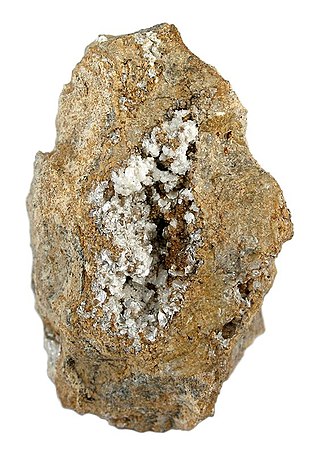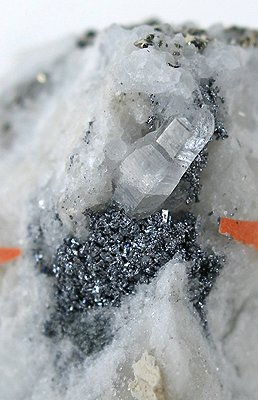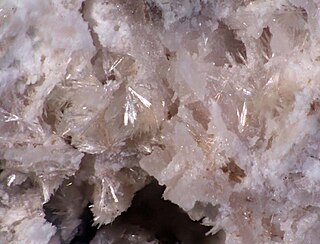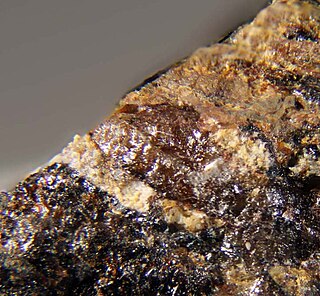Related Research Articles

Dickite is a phyllosilicate clay mineral named after the metallurgical chemist Allan Brugh Dick, who first described it. It is chemically composed of 20.90% aluminium, 21.76% silicon, 1.56% hydrogen and 55.78% oxygen. It has the same composition as kaolinite, nacrite, and halloysite, but with a different crystal structure (polymorph). Dickite sometimes contains impurities such as titanium, iron, magnesium, calcium, sodium and potassium.
Cleusonite is a member of the crichtonite group of minerals with the chemical formula (Pb,Sr)(U4+
,U6+
)(Fe2+
,Zn)
2(Ti,Fe2+
,Fe3+
)
18(O,OH)
38. This group of minerals contains approximately thirteen complex metal titanates. The structures of minerals of this group is complicated by frequent fine-scale twinning and metamictization due to radioactive elements. The crichtonite group consists of members of related mineral species of the type A{BC2D6E12}O38 which are characterized by their predominant cations (as seen in crichtonite (Sr), senaite (Pb), davidite (REE + U), landauite (Na), loveringite (Ca), lindsleyite (Ba), and mathiasite (K).

Braggite is a sulfide mineral of platinum, palladium and nickel with chemical formula: S. It is a dense, steel grey, opaque mineral which crystallizes in the tetragonal crystal system. It is the central member in the platinum group end-members cooperite and vysotskite.

Edenite is a double chain silicate mineral of the amphibole group with the general chemical composition NaCa2Mg5(Si7Al)O22(OH)2. Edenite is named for the locality of Edenville, Orange County, New York, where it was first described.

Marrite (mar'-ite) is a mineral with the chemical formula PbAgAsS3. It is the arsenic equivalent of freieslebenite (PbAgSbS3), but also displays close polyhedral characteristics with sicherite and diaphorite. Marrite was named in honor of geologist John Edward Marr (1857–1933) of Cambridge, England.
Jonesite is a mineral with the chemical formula Ba4(K,Na)2[Ti4Al2Si10O36]*6H2O. This mineral is named after Francis Tucker Jones (1905–1993), who discovered the mineral while working as a Research Chemical Microscopist at Berkeley in CA. Jonesite has diffraction symmetry of mmm, which implies an orthorhombic system with all three axes perpendicular to each other and the angles between each axis equal to 90 degrees. In addition to symmetrical properties, Jonesite is a biaxial mineral with birefringence, which is a term to describe the difference between index of refraction. Jonesite is anisotropic, meaning the speed of light changes through the mineral, so the mineral shows color when viewed in crossed polarized light under a microscope. The mineral also has medium relief, which is a measure of how well the mineral stands out when viewed under a microscope in plane polarized light. In addition to being one of the rarest minerals in the Benitoite Gem mine located in California, Jonesite also is the first titanosilicate mineral with a porous double-layered crystal structure. This discovery is important because titanosilicate frameworks have industrial uses in energy companies and are used in containing radioactive waste.
Kochite is a rare silicate mineral with chemical formula of (Na,Ca)3Ca2(Mn,Ca)ZrTi[(F,O)4(Si2O7)2] or double that. Kochite is a member of the rosenbuschite group.
Naldrettite is a mineral with a chemical formula of Pd2Sb. It is named after Anthony J. Naldrett (born 1933), a professor at the University of Toronto, who has made significant contributions to the International Mineralogical Association (IMA). Naldrettite is a new intermetallic mineral from the Mesamax Northwest deposit, Ungava region, Québec, Canada. Mineralization takes place around the base of basaltic dyke margins. Naldrettite is economically important because of its chemical composition (Pd2Sb). The sample in which the new mineral was discovered had high platinum group elements (PGEs) with palladium enrichment.

Christite is a mineral with the chemical formula TlHgAsS3. It is named after Dr. Charles L. Christ, a member of the U.S. Geological Survey. It usually comes in a crimson red or bright orange color. It has a density of 6.2 and has a rating between 1 and 2 on Mohs Hardness Scale. Christite has an adamantine luster and leaves behind an orange streak. Its crystal system is monoclinic with possible crystal classes of twofold symmetry, mirror plane symmetry, and twofold with a mirror plane. This means it can have radial symmetry, mirror plane symmetry, or mirror plane symmetry perpendicular to the two-fold axis. It is an anisotropic mineral, which means that it exhibits different properties when measured in different directions. In plane polarized light, its color is golden yellow. It is birefringent, which means that it has two distinct indices of refraction. This can be seen when one looks through the microscope with both polars crossed and sees the mineral change colors when it is rotated.
Sewardite is a rare arsenate mineral with formula of CaFe2+3(AsO4)2(OH)2. Sewardite was discovered in 1982 and named for the mineralogist, Terry M. Seward (born 1940), a professor of geochemistry in Zürich, Switzerland.
Skaergaardite is an intermetallic platinum group mineral with the general chemical formula PdCu. The mineral is named after its discovery location: the Skaergaard intrusion, Kangerdlugssuaq area, East Greenland. The mineral name was approved by the International Mineralogical Association in 2003. The mineral has also been reported in the Duluth intrusion in Minnesota and the Rum layered intrusion in Scotland.

Annite is a phyllosilicate mineral in the mica family. It has a chemical formula of KFe32+AlSi3O10(OH)2. Annite is the iron end member of the biotite mica group, the iron rich analogue of magnesium rich phlogopite. Annite is monoclinic and contains tabular crystals and cleavage fragments with pseudohexagonal outlines. There are contact twins with composition surface {001} and twin axis {310}.

The silver antimonide mineral dyscrasite has the chemical formula Ag3Sb. It is an opaque, silver white, metallic mineral which crystallizes in the orthorhombic crystal system. It forms pyramidal crystals up to 5 cm (2.0 in) and can also form cylindrical and prismatic crystals.

Laplandite has a general formula of Na4CeTiPO4Si7O18•5H2O, and is found primarily in igneous rocks. This silicate mineral has been found as inclusions in pegmatites, primarily in the Kola Peninsula in Lappland, where the mineral's name gets its origin. Laplandite is orthorhombic, which states that crystallographically, it contains three axes of unequal lengths that all intersect at 90 degrees, perpendicular to one another. The shape of the crystal is bipyramidal, and is similar in structure to olivine or aragonite. Because of these different axes lengths, it shows anisotropism, which will allow for the visibility of birefringence. This property can give the mineral very distinct colors when viewed under cross-polarization. Laplandite has three different indices of refraction, which are measures of the speed of light in vacuum divided by the speed of light within the mineral, determined individually on each axis. Due to these different indices, Laplandite is a biaxial mineral, which states that the mineral will have two optic axes. Under the microscope, this mineral has moderate relief, which describes the contrast between Laplandite's refractive index and the refractive index of the mounting medium on which it is placed. The relief can be seen physically as how easily you can see the boundary lines of the mineral under plane polarized light in a petrographic microscope.

Perite is a mineral that has a general chemical formula of PbBiO2Cl. The name is given for Per Adolf Geijer, a Swedish economic geologist with the Geological Survey of Sweden, who discovered the mineral in 1960 outside of Langban, Sweden. Perite is orthorhombic, space group Cmcm {C2/m 2/c 21/m}. In terms of its optical properties, Perite is anisotropic which means the velocity of light varies depending on direction through the mineral (i.e. it is birefringent). Its calculated relief is 1.45-1.461, which is moderate. It is colorless in plane polarized light, and it is weakly pleochroic. Perite is found in areas near igneous extrusions in places like the Western United States, Southern Australia, and scattered around Europe.

Vladimirite is a rare calcium arsenate mineral with a formula of Ca5(HAsO4)2(AsO4)2·5H2O. It is named after the Vladimirovskoye deposit in Russia, where it was discovered in the 1950s.

Fluor-uvite is a tourmaline mineral with the chemical formula CaMg3(Al5Mg)(Si6O18)(BO3)3(OH)3F. It is a rare mineral that is found in calcium rich contact metamorphic rocks with increased amounts of boron. Uvite is trigonal hexagonal, which means that it has three equal length axes at 120 degrees, all perpendicular to its fourth axis which has a different length. Uvite is part of the space group 3m. Uvite's hardness has been measured to be 7.5 on the Mohs hardness scale. The color of uvite widely varies, depending on the sample, but is mostly deep green or brown. In regard to uvite's optical properties, it is uniaxial (-) and anisotropic, meaning that the velocity of light in the mineral depends on the path that it takes. In plane polarized light, uvite is colorless to pale yellow and shows weak pleochroism.
Dessauite-(Y) is a mineral member of the crichtonite group with the formula (Sr,Pb)(Y,U)(Ti,Fe3+
)
20O
38. It is associated with derbylite, hematite, rutile, karelianite, siderite, and calcite. Founded in the Buca della Vena Mine, Tuscany, Italy, the mineral was called dessauite in honor of professor Gabor Dessau (1907–1983).

Jinshajiangite is a rare silicate mineral named after the Jinshajiang river in China. Its currently accepted formula is BaNaFe4Ti2(Si2O7)2O2(OH)2F. It gives a name of the jinshajiangite group. The mineral is associated with alkaline rocks. In jinshajiangite, there is a potassium-to-barium, calcium-to-sodium, manganese-to-iron and iron-to-titanium diadochy substitution. Jinshajiangite is the iron-analogue of surkhobite and perraultite. It is chemically related to bafertisite, cámaraite and emmerichite. Its structure is related to that of bafertisite. Jinshajiangite is a titanosilicate with heteropolyhedral HOH layers, where the H-layer is a mixed tetrahedral-octahedral layer, and the O-layer is simply octahedral.

Wöhlerite, also known as wöehlerite is a member of the amphibole supergroup, and the wöhlerite subgroup within it. It was named after German chemist Friedrich Wöhler. It was first described by Scheerer in 1843, but the crystal structure was later solved by Mellino & Merlino in 1979. Once approved, it was grandfathered by the IMA.
References
- ↑ Warr, L.N. (2021). "IMA–CNMNC approved mineral symbols". Mineralogical Magazine. 85 (3): 291–320. Bibcode:2021MinM...85..291W. doi: 10.1180/mgm.2021.43 . S2CID 235729616.
- 1 2 Webmineral data
- 1 2 3 Mindat with locations
- 1 2 3 4 Handbook of Mineralogy
- ↑ Stribrny, B., Wellmer, F. W., Burgath, K. P., Oberthür, T., Tarkian, M., Pfeiffer, T. (2000). "Unconventional PGE occurrences and PGE mineralization in the Great Dyke: metallogenic and economic aspects". Mineralium Deposita. 35 (2–3): 260–280. Bibcode:2000MinDe..35..260S. doi:10.1007/s001260050019. S2CID 129011473.
{{cite journal}}: CS1 maint: multiple names: authors list (link) - ↑ Gatehouse, B. M., I. E. Grey, I. H. Campbell and P. Kelly (1978). The crystal structure of loveringite-a new member of the crichtonite group. American Mineralogist, 63, 28-36